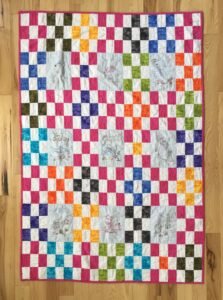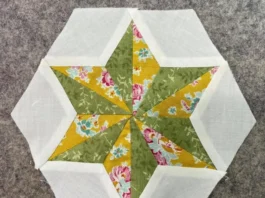The Nine Patch Quilt Block is one of the most beloved and versatile quilt patterns in the world of quilting. Its simplicity and adaptability make it an excellent choice for beginners, while seasoned quilters can explore endless variations.
In this tutorial, we will take you through the step-by-step process of creating your own Nine Patch Quilt Block, with detailed instructions on fabric cuts, measurements, and sewing techniques.
Whether you’re new to quilting or looking for a classic project to add to your collection, this guide will help you master this timeless design.

What is the Nine Patch Quilt Block?
The Nine Patch Quilt Block is one of the most traditional quilt patterns, composed of nine smaller squares arranged in a three-by-three grid. This pattern is not only easy to construct but also offers numerous design possibilities by playing with colors and fabric choices. The simplicity of the block makes it a popular choice for quilts of all sizes, from baby quilts to king-size bed covers.
Many quilters love the Nine Patch because it can be adapted to both modern and traditional quilting styles. By using different fabrics, colors, and textures, you can create a block that reflects your personal taste. Additionally, it’s a great quilt block for using up fabric scraps, making it both economical and sustainable for those who love to sew.
For those just starting their quilting journey, the Nine Patch Quilt Block is an excellent way to learn essential skills such as accurate cutting, piecing, and pressing. The straightforward structure allows you to focus on perfecting these basic techniques while still achieving a professional-looking quilt.
Fabric Selection and Preparation
Choosing the right fabrics for your Nine Patch Quilt Block is the first step to ensuring a beautiful final product. For a classic look, you can opt for contrasting colors, such as a light and dark fabric combination. Alternatively, you can create a more modern design by using various shades within the same color family or even experimenting with patterned fabrics.
When selecting fabrics, be sure to choose 100% cotton quilting fabric, as it is the most durable and easiest to work with. Prewash your fabric to prevent any shrinkage after the quilt is completed. This will also ensure that the colors don’t bleed during the quilting process. Once your fabric is prepped, iron it to remove any wrinkles, which will make it easier to cut and sew accurately.
Before you begin cutting, it’s essential to have a clear plan. The standard size for a Nine Patch Quilt Block is 6 inches finished (6.5 inches unfinished), but you can adjust the size according to your project. For this tutorial, we will use the standard 6.5-inch unfinished block.
Fabric Cutting Measurements
Accurate fabric cutting is key to a successful quilt block. For a traditional 6.5-inch Nine Patch Quilt Block, you will need to cut the following:
- 5 squares of dark fabric measuring 2.5 inches by 2.5 inches
- 4 squares of light fabric measuring 2.5 inches by 2.5 inches
These measurements will create a balanced block with a checkerboard appearance. If you want to make a larger block, you can increase the size of the squares while maintaining the same 3×3 grid structure. Use a rotary cutter, cutting mat, and quilting ruler to ensure precision when cutting your fabric.
If you’re making a larger quilt, consider cutting all your squares in advance. This will save time during the piecing process and ensure consistency across your quilt blocks. Organize your squares by color and size to keep your workspace tidy and efficient.
Assembling the Nine Patch Quilt Block
Now that you have your fabric squares cut, it’s time to assemble the Nine Patch Quilt Block. Begin by laying out your squares in a 3×3 grid, alternating between light and dark fabrics. The center square should be a dark fabric square to create the classic Nine Patch look.
Once your layout is ready, start by sewing the squares together in rows. Place two squares right sides together and sew along the edge with a 1/4-inch seam allowance. After sewing two squares, add the third square to complete the row. Repeat this process for all three rows, ensuring the seams are straight and even.
Press the seams of each row in opposite directions. For example, press the seams of the first row to the right and the second row to the left. This will help the seams nest together when you sew the rows together, creating a flatter quilt block with less bulk.
Sewing the Rows Together
After sewing and pressing the rows, it’s time to join them to form the final Nine Patch Quilt Block. Align the rows carefully, making sure the seams match up where the squares meet. Pin the rows in place to prevent any shifting while you sew.
Sew the first two rows together using a 1/4-inch seam allowance. Press the seam flat, then add the third row and repeat the process. Be sure to press the final seam in one direction to keep the block smooth and flat.
Once all three rows are sewn together, give the entire block a final press. Your Nine Patch Quilt Block should now measure 6.5 inches, with crisp seams and neatly aligned squares. If the block is slightly uneven, you can trim it to size using a rotary cutter and ruler.
Variations of the Nine Patch Quilt Block
One of the best things about the Nine Patch Quilt Block is its versatility. By changing the placement of fabrics or incorporating different colors and patterns, you can create various looks from this simple design. For example, you can create a scrappy Nine Patch by using a variety of different fabrics for each square, or opt for a more uniform look by using just two fabrics.
Another variation is the Disappearing Nine Patch, where the finished Nine Patch Block is cut into quarters and rearranged to create a more complex design. This is a great way to add a unique twist to a traditional quilt pattern while still keeping the process simple.
Experiment with different fabric placements and layouts to find the design that suits your style. The Nine Patch Quilt Block can be used as a standalone block, or combined with other blocks to create a stunning quilt.
Final Tips for Quilting Success
As you work on your Nine Patch Quilt Block, remember that accuracy is key. Take your time with each step, from cutting the fabric to sewing the seams. Use a quarter-inch foot on your sewing machine to ensure consistent seam allowances, which will make assembling your quilt easier.
Pressing your seams as you go is another essential tip for creating a professional-looking quilt block. Proper pressing helps the fabric lay flat and reduces bulk at the seams, making the quilting process smoother.
Finally, have fun with the process! Quilting is both an art and a craft, and the Nine Patch Quilt Block offers endless opportunities for creativity.
Whether you’re making a full-sized quilt or a smaller project, this classic block is sure to become a favorite in your quilting repertoire.



